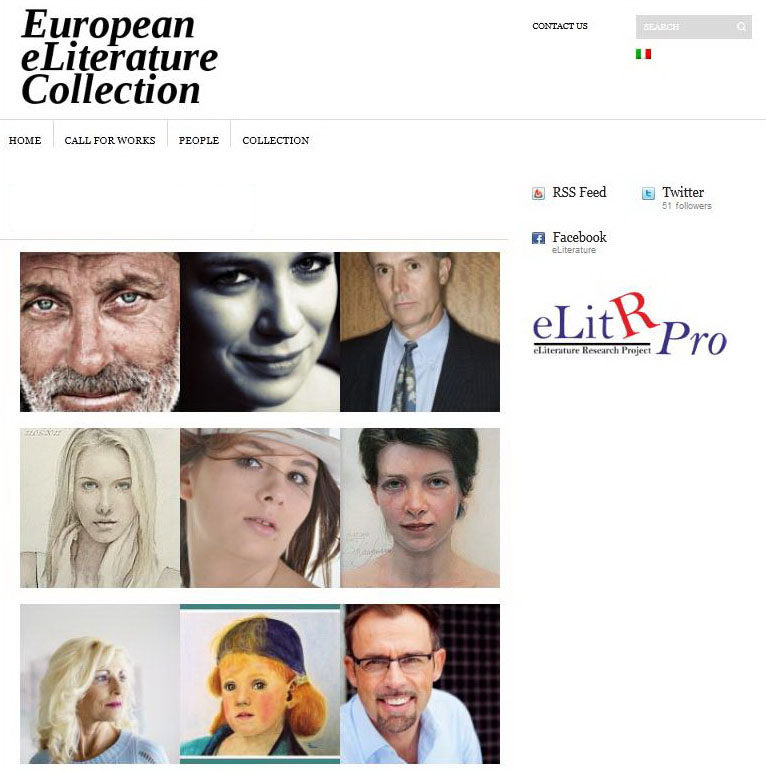Search
The search found 46 results in 0.009 seconds.
Search results
-
Electronic Literature Collection, Volume Two
A Creative-Commons licensed anthology collecting sixty-three works of electronic literature that can be browsed by author, title, and keyword. Contributions are from the following: Countries: Austria, Australia, Catalonia, Canada, Colombia, France, Germany, Israel, The Netherlands, Portugal, Peru, Spain, United Kingdom, United States of America Languages: Catalan, Dutch, English, French, German, Portuguese, Spanish Formats: Flash, Processing, Java, JavaScript, Inform, HTML, C++
Eric Dean Rasmussen - 18.02.2011 - 18:11
-
Electronic Literature Collection, Volume One
Electronic Literature Collection, Volume One
Eric Dean Rasmussen - 18.02.2011 - 18:16
-
New Media Art
New Media Art
Meri Alexandra Raita - 02.10.2011 - 14:37
-
European eLiterature Collection
The European eLiterature Collection is a project developed as part of The eLiterature Research Project. The aim of the collection is to provide an essential tool to assist in formalizing e-Literature in Europe.
In this respect, the European eLiterature Collection Board of Editors, evaluates, reviews, and publishes on the web works of Electronic Literature by European authors.

Fabio De Vivo - 22.10.2011 - 12:16
-
Against Expression: An Anthology of Conceptual Writing
In much the same way that photography forced painting to move in new directions, the advent of the World Wide Web, with its proliferation of easily transferable and manipulated text, forces us to think about writing, creativity, and the materiality of language in new ways. In Against Expression, editors Craig Dworkin and Kenneth Goldsmith present the most innovative works responding to the challenges posed by these developments. Charles Bernstein has described conceptual poetry as "poetry pregnant with thought." Against Expression, the premier anthology of conceptual writing, presents work that is by turns thoughtful, funny, provocative, and disturbing. Dworkin and Goldsmith, two of the leading spokespersons and practitioners of conceptual writing, chart the trajectory of the conceptual aesthetic from early precursors including Samuel Beckett and Marcel Duchamp to the most prominent of today’s writers.
Jill Walker Rettberg - 09.12.2011 - 10:03
-
Computer Poems
"In his preface to the anthology Computer Poems (1973), Richard Bailey identifies four poetic tendencies that influenced the works included in the collection: "concrete poetry," "poetry of sound in verbal orchestrations," "imagistic poetry in the juxtaposition of the unfamiliar," and "haiku" (n.pag.). The poems in the anthology reasonably support his (somewhat) dated viewpoint, but there is a correspondence between poetry and digital poetry."
(Source: Chris Funkhouser in Digital Poetry: A Look at Generative, Visual, and Interconnected Possibilities in its First Four Decades)Elisabeth Nesheim - 03.02.2012 - 15:57
-
Poems for the Millennium I
Poems for the Millennium I
Meri Alexandra Raita - 11.02.2012 - 20:27
-
Postmodern American Fiction: A Norton Anthology
Postmodern American Fiction: A Norton Anthology
Eric Dean Rasmussen - 16.02.2012 - 20:51
-
ELMCIP Anthology of European Electronic Literature
The ELMCIP Anthology of European Electronic Literature is an output from the ELMCIP researchers based at Blekinge Tekniska Högskola (Blekinge Institute of Technology) in Sweden. The anthology is intended to provide educators, students and the general public with a free curricular resource of electronic literary works produced in Europe. The works were selected, after an open call, based on four main criteria:
Eric Dean Rasmussen - 16.05.2012 - 11:06
-
Art and Electronic Media
Art and Electronic Media is part of the Themes and Movements series published by Phaidon Press. This book demonstrates the formidable history of artistic uses of electronic media, a history that parallels the growing pervasiveness of technology in all facets of life. Over 200 artists and institutions from more than 30 countries are represented. The centrality of artists as theorists and critics is reflected in the focus on artists’ writings. The goal is to enable the rich genealogy of art and electronic media to be understood and seen – literally and figuratively – as central to the histories of art and visual culture.
Elisabeth Nesheim - 07.03.2013 - 15:18

